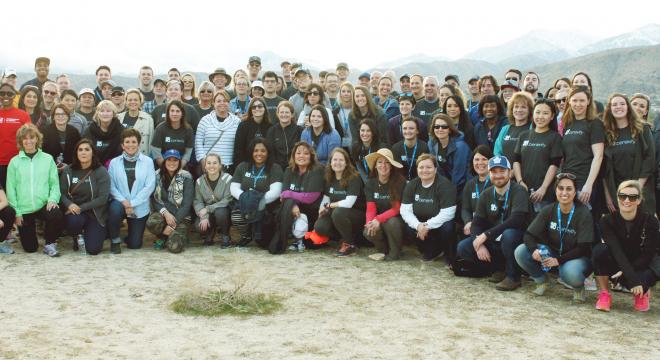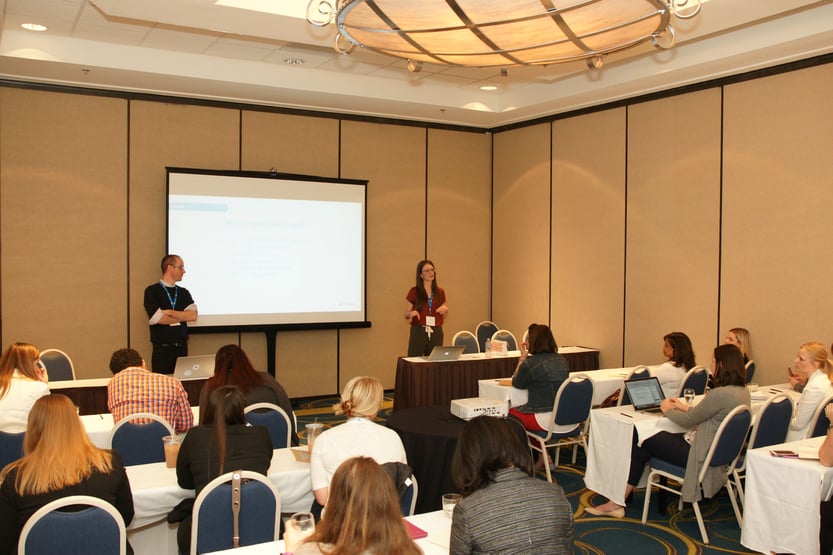February 15, 2017
When you get more than 200 DoGooders together in a desert, great things happen. The passion and enthusiasm from everyone who attended our annual Goodness Matters client conference last week was incredible, and we left Palm Springs more convinced than ever that we, as companies, have an incredible opportunity to create the change we want to see in the world.
 96 corporate citizenship leaders joined the Mojave Desert Land Trust (MDLT) for a stewardship event organized by Benevity. The desert cleanup took place on an MDLT property, a wilderness corridor located within the Sand to Snow National Monument.
96 corporate citizenship leaders joined the Mojave Desert Land Trust (MDLT) for a stewardship event organized by Benevity. The desert cleanup took place on an MDLT property, a wilderness corridor located within the Sand to Snow National Monument.
We hope the stories, challenges and solutions that were shared by our clients, industry experts and Benevity-ites created a sandstorm of inspiration that will help you take your programs to the next level. And to keep the momentum going, we pulled together some of the big ideas and learnings with 5 key takeaways — because this was more than just a palm-covered getaway (though it was certainly beautiful). It was a starting point for all of us to make Goodness matter (even) more!
 A Panel discusses the role of Goodness in powering a positive company culture. From left to right: Bryan de Lottinville (Founder & CEO, Benevity), Josh Levine (Principal of Great Monday and Co-founder of CultureLabx), Deborah Swartz (Corporate Citizenship Lead for Canada from Accenture Canada), Diane Solinger (Director of GooglersGive from Google).
A Panel discusses the role of Goodness in powering a positive company culture. From left to right: Bryan de Lottinville (Founder & CEO, Benevity), Josh Levine (Principal of Great Monday and Co-founder of CultureLabx), Deborah Swartz (Corporate Citizenship Lead for Canada from Accenture Canada), Diane Solinger (Director of GooglersGive from Google).
1. Use Goodness to power your corporate culture
Talk to almost any C-Suite person and they’ll tell you that culture is one of the biggest strategic challenges they face. You’ve got a huge opportunity to help change that. By leveraging your giving and volunteering programs to create a workplace for everyone, built by everyone, you’re creating a purpose-driven culture that today’s diverse workforce is really looking for.
This cultural shift means Goodness is no longer a citizenship-only function, but the real future of human capital management (and a key to recruitment, retention and engagement!). As Culture and Brand Strategist Josh Levine from CultureLabx, eloquently put it, “culture is the cause and effect of every decision we make.” It’s the most compelling sustainable advantage that not only affects your company’s bottom line, but also the relationship you have with your people.
So how do you start to make the shift? The advice we heard from both Deborah Swartz (Accenture) and Diane Solinger (Google) was to listen to your people. Talk to them, ask them what they want and get them involved early.
“Bring your employees in to do moonshot, blue-sky thinking. You’ve got people invested who will be using the program. Then launch, iterate and move along. Get to a place where people are invested in the product. Then it’s theirs, not yours.”
– Diane Solinger, Google
 Goodness Matters attendees enjoy lunch on the Starlight Terrace.
Goodness Matters attendees enjoy lunch on the Starlight Terrace.
2. Leverage the power of the crowd
Now, more than ever, companies have an incredible opportunity to tap into the passions of their people to create deeper engagement.
People are hungry to do Good, and they’re already doing it. So why not harness the reach, resources and appetite to take your program — and your business — to the next level? Corporate social responsibility (CSR) programs have traditionally focused on a small number of relevant and strategically-aligned pillars and goals.
They’re historically vertical in structure, and that’s not necessarily wrong, but the world around us has become an increasingly grassroots, crowd-sourced, horizontal kind of place. This Uberization (or Lyft, if you will) of society can, and should, be applied to the CSR world as well.
There’s a lot of power in an “and” approach, that allows you to connect with people on issues that resonate personally with them, creating citizen philanthropists in the process.
 The UN Sustainable Development Goals, also known as the 17 Global Goals.
The UN Sustainable Development Goals, also known as the 17 Global Goals.
3. Rally your people around the Sustainable Development Goals
The Sustainable Development Goals (SDGs) are gaining serious momentum, yet we’re still seeing relatively little action from company leaders, and many employees are just learning what these goals are. If you’re already folding the SDGs into your program, you probably feel like a bit of a pioneer, but you won’t be alone for long.
Employees, customers, clients, investors and everyone else is starting to demand that companies get on board. In fact, 81% of Millennials expect businesses to act on the SDGs, according to a recent Corporate Citizenship Study.
Several corporations have already begun to align their business practices with one or all of the goals, and there’s now a tremendous opportunity to take that a step further to get employees involved at a grassroots level, too.
The best way to get started is by spreading the word. Clearly introduce the idea to your people. Educate them on what the SDGs are and how you plan to support them. Spark can be one of your best tools. Right now we’re working on ways to help you share Giving Opportunities and News Items, to quickly and easily create campaigns around any of the SDGs your company aligns closely with.
Chat with your Benevity Relationship Manager if you have any questions or want help setting up an SDG campaign.
 Katy Davis, Managing Director of ideas42, explains the role of behavioral science in helping more people engage in charitable giving.
Katy Davis, Managing Director of ideas42, explains the role of behavioral science in helping more people engage in charitable giving.
4. Create more engaged givers through behavioral science
We know giving tends to be impulsive and responsive in nature. When a friend asks us to donate to their fundraising run, we give, even if the cause doesn’t resonate with us personally.
There’s a gap between how we intend to give and how we actually give, which could be the reason that, on average, we also give less than we say we should. So how do we move people from passive, transactional interactions with our programs to richer, more intentional interactions where there’s co-creation and co-ownership of the outcomes?
Behavioral science.
Understanding what makes people tick can help remove the barriers to giving and shrink the gap between intent and action.
At Goodness Matters, Katy Davis of ideas42 stressed that the way we all design programs and products truly matters.
The more we understand about people, the more success we’ll have in our programs, so we’ve been working with the Bill and Melinda Gates Foundation and ideas42 to take people-centric giving to the next level. As it turns out, most people are a lot like Elaine from Seinfeld — somewhere between logical Spock and impulsive Homer — so we need to work on designing smart solutions for all of the smart yet impulsive Elaine Beneses of the world.
 Goodness Matters attendees learn in a breakout session hosted by Andrew Wedderburn (Manager of Communications & Brand, Benevity) and Stephanie Mayguard (Project Manager, Benevity).
Goodness Matters attendees learn in a breakout session hosted by Andrew Wedderburn (Manager of Communications & Brand, Benevity) and Stephanie Mayguard (Project Manager, Benevity).
5. Do more through integration and collaboration
Our clients tell us again and again that they’re under-resourced. They have the passion and ambition of 100 people, but might have 10, 3 or even one person actually running their programs. The good news is that you don’t necessarily need more people or a bigger budget to increase your impact.
One of the best ways to move the needle is to integrate your programs and collaborate with other teams who share your goals.
Giving, volunteering and grantmaking don’t have to operate separately and, in fact, are usually better run together. Not to mention other initiatives like sustainability and health and wellness that are gaining traction in companies.
And the best way to grow your team is likely to use the people you already have, in other areas of your business.
We’re seeing a growing number of companies embedding their giving and volunteering program leads into their people teams (or HR functions) because they recognize that they share the same objectives.
At Goodness Matters, Stacey Nelson-Kumar from Cargill echoed the need to work with HR from the outset. She realized that their Goodness program was focused on participation and engagement, while the HR team’s focus was on recruitment, development and... engagement!
They had the same goal in mind, so why not work together and share resources for a bigger business and social impact?
Bringing your HR or People team into the fold can also help you build champions for your program and get more stakeholder buy-in down the road.
 Sona Khosla, VP Marketing at Benevity, shares tips and tactics on the power of promotion.
Sona Khosla, VP Marketing at Benevity, shares tips and tactics on the power of promotion.
Bonus: Call on your people to help promote your program
One of the best ways to increase participation in your program is to promote it. That might seem obvious, but you really can’t over-communicate what you’re doing. We’ve been looking at a growing body of evidence for why people don’t get involved, and the number one reason is that they haven’t been asked. Use every channel you’ve got to build awareness — company emails, Spark bulk emails and news items, posters, peer-to-peer.
That last one is big. Tap your most passionate people to help spread the word. When the message comes from a peer it gives it a humanizing force, and we’re more likely to want to want to get involved if a friend, colleague or someone we admire invites us to participate in a giving campaign or volunteering event.
In this way, Goodness becomes a part of your day-to-day culture. Also, consider partnering with other departments to spread the word further. This could be your People team (HR) or maybe a C-level executive (leadership support goes a long way in rallying your people!).
And the last but most important tip for promoting your program? Be bold, get creative, try new things, and most of all, have fun!
We hope these 5 (er, 6) takeaways will help you on the road to achieving your goals in the year ahead. Even small changes can make a huge difference, creating more and more engagement as you grow. It takes time, and it’s not always easy, but you have so many tools at your fingertips already.
And what we’ve learned from some of the most successful corporate giving programs is that having strong leadership support will help you rally your people (and vice versa — as you start to engage your people more, your senior leadership will see the impact you’re making on the business), so continue championing the value of your programs internally.
You have an incredible opportunity to make a big impact on your people, your company and your community.

